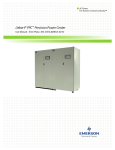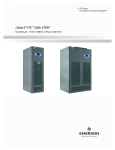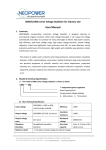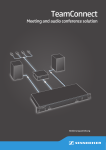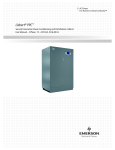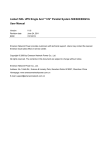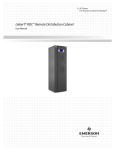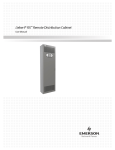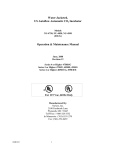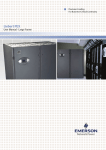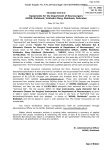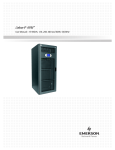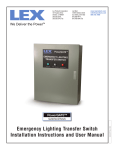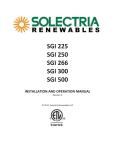Download Liebert® PPC™ - Emerson Network Power
Transcript
AC Power For Business-Critical Continuity™ Liebert® PPC™ Second Generation Power and Distribution Cabinet User Manual - 150, 200, 225, 300, 430 & 800kVA; PDU for Two-Stage Distribution, Three-Phase, 60 Hz TABLE OF CONTENTS IMPORTANT SAFETY INSTRUCTIONS . . . . . . . . . . . . . . . . . . . . . . . . . . . . . . . . . . . . . . . . . . . . . . . .1 SAVE THESE INSTRUCTIONS . . . . . . . . . . . . . . . . . . . . . . . . . . . . . . . . . . . . . . . . . . . . . . . . .1 1.0 INSTALLATION INSTRUCTIONS . . . . . . . . . . . . . . . . . . . . . . . . . . . . . . . . . . . . . . . . . . . . . . .2 1.1 Unpacking and Installation . . . . . . . . . . . . . . . . . . . . . . . . . . . . . . . . . . . . . . . . . . . . . . . . . . . . 2 1.1.1 1.1.2 1.1.3 1.1.4 1.2 Unpacking and Preliminary Inspection . . . . . . . . . . . . . . . . . . . . . . . . . . . . . . . . . . . . . . . . . . . Handling Considerations . . . . . . . . . . . . . . . . . . . . . . . . . . . . . . . . . . . . . . . . . . . . . . . . . . . . . . . Unit Preparation. . . . . . . . . . . . . . . . . . . . . . . . . . . . . . . . . . . . . . . . . . . . . . . . . . . . . . . . . . . . . . Location Considerations. . . . . . . . . . . . . . . . . . . . . . . . . . . . . . . . . . . . . . . . . . . . . . . . . . . . . . . . 2 2 3 4 Power and Control Wiring . . . . . . . . . . . . . . . . . . . . . . . . . . . . . . . . . . . . . . . . . . . . . . . . . . . . . 6 1.2.1 1.2.2 1.2.3 1.2.4 1.2.5 1.2.6 1.2.7 Distribution Section Mounting and Wiring . . . . . . . . . . . . . . . . . . . . . . . . . . . . . . . . . . . . . . . . 6 Side-Section Electrical Connections . . . . . . . . . . . . . . . . . . . . . . . . . . . . . . . . . . . . . . . . . . . . . . 8 Input Power Connections . . . . . . . . . . . . . . . . . . . . . . . . . . . . . . . . . . . . . . . . . . . . . . . . . . . . . . . 9 System Grounding . . . . . . . . . . . . . . . . . . . . . . . . . . . . . . . . . . . . . . . . . . . . . . . . . . . . . . . . . . . 10 Grounding Electrode Conductor . . . . . . . . . . . . . . . . . . . . . . . . . . . . . . . . . . . . . . . . . . . . . . . . 10 Output Power Connections . . . . . . . . . . . . . . . . . . . . . . . . . . . . . . . . . . . . . . . . . . . . . . . . . . . . 10 Control Wiring Connections. . . . . . . . . . . . . . . . . . . . . . . . . . . . . . . . . . . . . . . . . . . . . . . . . . . . 12 2.0 INSPECTION AND STARTUP CHECKLIST . . . . . . . . . . . . . . . . . . . . . . . . . . . . . . . . . . . . . . . 14 2.1 Internal Inspection Overview . . . . . . . . . . . . . . . . . . . . . . . . . . . . . . . . . . . . . . . . . . . . . . . . . 14 2.2 Internal Inspection Procedure . . . . . . . . . . . . . . . . . . . . . . . . . . . . . . . . . . . . . . . . . . . . . . . . . 14 2.3 Startup and Monitoring System Check Overview . . . . . . . . . . . . . . . . . . . . . . . . . . . . . . . . . 15 2.4 Startup Procedure . . . . . . . . . . . . . . . . . . . . . . . . . . . . . . . . . . . . . . . . . . . . . . . . . . . . . . . . . . 16 2.5 Monitoring System Check . . . . . . . . . . . . . . . . . . . . . . . . . . . . . . . . . . . . . . . . . . . . . . . . . . . . 17 2.6 Send Completed Checklist to Emerson Network Power . . . . . . . . . . . . . . . . . . . . . . . . . . . . 17 3.0 OPERATING INSTRUCTIONS . . . . . . . . . . . . . . . . . . . . . . . . . . . . . . . . . . . . . . . . . . . . . . . . 18 3.1 Startup Procedures. . . . . . . . . . . . . . . . . . . . . . . . . . . . . . . . . . . . . . . . . . . . . . . . . . . . . . . . . . 18 3.1.1 3.1.2 3.1.3 3.1.4 Emergency Shutdown. . . . . . . . . . . . . . . . . . . . . . . . . . . . . . . . . . . . . . . . . . . . . . . . . . . . . . . . . Normal System Shutdown . . . . . . . . . . . . . . . . . . . . . . . . . . . . . . . . . . . . . . . . . . . . . . . . . . . . . Normal System Startup . . . . . . . . . . . . . . . . . . . . . . . . . . . . . . . . . . . . . . . . . . . . . . . . . . . . . . . Manual Restart. . . . . . . . . . . . . . . . . . . . . . . . . . . . . . . . . . . . . . . . . . . . . . . . . . . . . . . . . . . . . . 18 18 19 19 3.2 Basic Monitor Panel . . . . . . . . . . . . . . . . . . . . . . . . . . . . . . . . . . . . . . . . . . . . . . . . . . . . . . . . . 20 3.3 Power Monitor Panel . . . . . . . . . . . . . . . . . . . . . . . . . . . . . . . . . . . . . . . . . . . . . . . . . . . . . . . . 21 3.4 Liebert Current Plus Monitoring (If Supplied). . . . . . . . . . . . . . . . . . . . . . . . . . . . . . . . . . . . 23 3.5 Liebert Distribution Monitoring (If Supplied) . . . . . . . . . . . . . . . . . . . . . . . . . . . . . . . . . . . . 25 4.0 MAINTENANCE . . . . . . . . . . . . . . . . . . . . . . . . . . . . . . . . . . . . . . . . . . . . . . . . . . . . . . . . . 27 4.1 Corrective Maintenance (Repair) . . . . . . . . . . . . . . . . . . . . . . . . . . . . . . . . . . . . . . . . . . . . . . 27 4.2 Preventive Maintenance (Inspection & Cleaning) . . . . . . . . . . . . . . . . . . . . . . . . . . . . . . . . . 27 4.2.1 Inspection Schedule . . . . . . . . . . . . . . . . . . . . . . . . . . . . . . . . . . . . . . . . . . . . . . . . . . . . . . . . . . 27 i FIGURES Figure 1 Figure 2 Figure 3 Figure 4 Figure 5 Figure 6 Figure 7 Figure 8 Figure 9 Figure 10 Figure 11 Figure 12 Figure 13 Recommended minimum service and ventilation clearances for 150 to 430kVA units . . . . . . . . . 4 Recommended minimum service and ventilation clearances for 800kVA units . . . . . . . . . . . . . . . 5 Footprint and floor cutout dimensions for Transformer Section - 150 to 430kVA units . . . . . . . . 5 Footprint and floor cutout dimensions for Transformer Section - 800kVA units . . . . . . . . . . . . . . 6 Footprint and floor cutout dimensions for Distribution Sections - 150-800kVA units . . . . . . . . . . 6 150-430kVA Liebert PPC single-line diagram . . . . . . . . . . . . . . . . . . . . . . . . . . . . . . . . . . . . . . . . . 7 800kVA Liebert PPC single-line diagram . . . . . . . . . . . . . . . . . . . . . . . . . . . . . . . . . . . . . . . . . . . . . 8 Typical Liebert PPC grounding arrangement . . . . . . . . . . . . . . . . . . . . . . . . . . . . . . . . . . . . . . . . . 11 Simplified shutdown circuit . . . . . . . . . . . . . . . . . . . . . . . . . . . . . . . . . . . . . . . . . . . . . . . . . . . . . . . 12 Typical control wiring for power monitoring . . . . . . . . . . . . . . . . . . . . . . . . . . . . . . . . . . . . . . . . . . 13 Acceptable hardware configurations for torque specifications . . . . . . . . . . . . . . . . . . . . . . . . . . . . 15 Liebert PPC with doors open—150, 200, 225 and 300kVA units . . . . . . . . . . . . . . . . . . . . . . . . . . 19 Monitor panel layout. . . . . . . . . . . . . . . . . . . . . . . . . . . . . . . . . . . . . . . . . . . . . . . . . . . . . . . . . . . . . 20 TABLES Table 1 Table 2 Table 3 Table 4 Table 5 Table 6 Table 7 Table 8 150-800kVA Liebert PPC dimensions . . . . . . . . . . . . . . . . . . . . . . . . . . . . . . . . . . . . . . . . . . . . . . . . 3 Heat output—Standard transformer, including distribution section . . . . . . . . . . . . . . . . . . . . . . . 4 Suggested minimum input wire size, 150 to 430kVA Liebert PPC . . . . . . . . . . . . . . . . . . . . . . . . . 7 250A to 700A MIB, 150-430kVA Liebert PPC. . . . . . . . . . . . . . . . . . . . . . . . . . . . . . . . . . . . . . . . . . 7 Suggested minimum input wire size, 800kVA Liebert PPC. . . . . . . . . . . . . . . . . . . . . . . . . . . . . . . 8 1000A to 1200A MIB, 800kVA Liebert PPC . . . . . . . . . . . . . . . . . . . . . . . . . . . . . . . . . . . . . . . . . . . 8 AIC and suggested minimum input wire size data for OCPD . . . . . . . . . . . . . . . . . . . . . . . . . . . . . 9 Torque specifications (unless otherwise labeled) . . . . . . . . . . . . . . . . . . . . . . . . . . . . . . . . . . . . . . 15 ii IMPORTANT SAFETY INSTRUCTIONS SAVE THESE INSTRUCTIONS NOTE Read the entire manual before installing or operating the system. ! WARNING Risk of cutting metal bands under tension. Can cause injury and death. The shipping bands may be under tension. Use appropriate eye, face and hand protection to safeguard against injury from band backlash. ! WARNING Risk of electric shock and arc flash. Can cause equipment damage, injury and death. Verify that all incoming line voltage (power) and low voltage (control) circuits are de-energized and locked out before installing cables or making connections, whether in the junction box or in the unit. Equipment inspection and startup should be performed only by trained personnel. Lethal voltages are present during startup procedures. Electrical safety precautions must be followed throughout inspection and startup. Only qualified service personnel should perform maintenance on the Liebert PPC. All voltage sources to the unit must be disconnected before inspecting or cleaning within the cabinet. Lethal voltages exist within the equipment during operation. Observe all warnings and cautions in this manual. Failure to comply may result in serious injury or death. Obtain qualified service for this equipment as instructed. The monitoring system contains a lithium battery for memory backup. Danger of explosion if battery is incorrectly replaced. Replace only with same or equivalent type. Dispose of used batteries according to manufacturer’s instructions. NOTE The unit should not be loosened from the shipping pallet until after all handling by forklift or pallet jack is completed. All power and control wiring should be installed by licensed electricians and must comply with the NEC and applicable codes. ELECTROMAGNETIC COMPATIBILITY—The Liebert PPC complies with the limits for a Class A Digital Device, pursuant to Part 15 of FCC rules. Operation is subject to the following two conditions: • This device may not cause harmful interference, and • This device must accept any interference received, including interference that may cause undesired operation. Operating this device in a residential area is likely to cause harmful interference that users must correct at their own expense. The Liebert PPC complies with the requirements of EMC Directive 2004/108/EC and the published technical standards. Continued compliance requires installation in accordance with these instructions and use of accessories approved by Emerson Network Power®. 1 Liebert® PPC™ Installation Instructions 1.0 INSTALLATION INSTRUCTIONS 1.1 Unpacking and Installation NOTE Read the entire manual before installing and operating the system. Upon receipt of a Liebert PPC, the installer should perform the following steps to ensure a quality installation. 1.1.1 Unpacking and Preliminary Inspection A quality installation begins on the receiving dock. 1. Inspect the shipping crate(s) for damage or signs of mishandling before unpacking the unit(s). Check Shock-Watch indicator. 2. Open the shipping crates carefully. (Use care to avoid puncturing the container with sharp objects that would damage the contents.) 3. Remove the packing and vapor barriers and inspect the equipment for any obvious shipping damages. NOTE The units should not be loosened from the shipping pallet until after all handling by forklift or pallet jack is completed. Complete internal inspection should be accomplished only after equipment positioning and prior to electrical hookup. If any damage as a result of shipping is observed, immediately file a damage claim with the shipping agency and forward a copy to: Liebert Corp. 1050 Dearborn Drive P.O. Box 29186 Columbus, Ohio 43229 USA 1.1.2 Handling Considerations The Liebert PPC is bolted to a wooden pallet to allow handling by forklift equipment. • Easily moved - The Liebert PPC is furnished with casters to allow the unit to be rolled into place after it has been unbolted from the pallet. • Check size and weight - Refer to Table 1 and the cabinet drawings furnished with the unit for size and weight information. • Plan the route - Decide the best route for the unit to follow to the installation area to ensure that all passages are large enough to accommodate the unit and the floors are adequate to support the weight. Is there adequate room in doorways, elevators, ramps, etc.? Are there any nonnegotiable corners or offsets in the hallways? • Move with care - To prevent panel damage, Emerson recommends removing the exterior panels before the unit is moved. When replacing panels, remember to reconnect all panel ground wires. Liebert® PPC™ 2 Installation Instructions Table 1 150-800kVA Liebert PPC dimensions Distribution Side Section(s) 1 Transformer Section Dimensions - in. (mm) kVA W D H Weight lb. (kg) 150 43 (1092) 2 32 (813) 77 (1956) 1600 (726) 200 2 1950 (885) 225 43 (1092) 43 (1092) 2 32 (813) 32 (813) 77 (1956) 77 (1956) 2100 (953) Dimensions - in. (mm) D H Weight lb. (kg) 43 (1092) 2 32 (813) 77 (1956) 650 (295) 43 (1092) 2 32 (813) 77 (1956) 650 (295) 43 (1092) 2 32 (813) 77 (1956) 650 (295) 2 W 300 43 (1092) 2 32 (813) 77 (1956) 2500 (1134) 43 (1092) 32 (813) 77 (1956) 650 (295) 430 61 (1549) 2 32 (813) 77 (1956) 3326 (1509) 43 (1092) 2 32 (813) 77 (1956) 650 (295) 6720 (3048) 2 32 (813) 77 (1956) 650 (295) 800 86 (2184) 32 (813) 77 (1956) 43 (1092) 1. 800kVA requires two (2) distribution side sections 2. Includes a 1" side panel 1.1.3 Unit Preparation The Liebert PPC may be easily removed from the shipping pallet and installed by the user. A typical procedure follows: 1. Set the palletized assembly in a level area. 2. Cut the shipping bands. ! WARNING Risk of cutting metal bands under tension. Can cause injury and death. The shipping bands may be under tension. Use appropriate eye, face and hand protection to safeguard against injury from band backlash. 3. Remove side and rear panels from the module. An Allen wrench for the side panels is furnished in the installation packet. (Carefully disconnect panel ground wires by pulling the easy-disconnect terminals at the unit frame.) 4. Remove the bolts holding the unit to the shipping pallet in each of the four bottom corners. 5. Remove shipping blocks from under the unit, then remove chocks from all casters. 6. Lift the unit off the pallet and set it on the floor. 7. Roll the unit to the installation location. For units located on a raised floor, use care when positioning the unit over the floor cutout to avoid casters falling through the cutout. NOTE Before maneuvering the unit into its final position, read and follow all advisories in the following section, 1.1.4 - Location Considerations. 3 Liebert® PPC™ Installation Instructions 1.1.4 Location Considerations The Liebert PPC should be installed as close to the load(s) it is supplying. The unit should not be located over combustible surfaces. Equipment location should employ the shortest output distribution cable runs consistent with logical equipment arrangement and allowances for future additions. Operating Environment - Ambient temperatures of 32°F to 104°F (0°C to 40°C) with a relative humidity of 0% to 95% (non-condensing). Top or Bottom Clearance is required for exit of cables and conduit. • For bottom exit, this clearance is automatically provided by a raised floor—minimum height 12 in. (305mm). • For top exit, this clearance is 18 in. (460mm). Recommended minimum service clearances are shown in Figure 1 (150 to 430kVA units) and Figure 2 (800kVA units). The indicated clearance at the front of the unit is required for service access by the National Electrical Code (NEC) (Article 110-26). Clearance above the unit is required for cooling air flow (exhaust). Heat Output - Like any electrical device, the Liebert PPC produces heat under normal operation. Include this heat output (see Table 2) when calculating the environmental conditions of the room. Table 2 Heat output—Standard transformer, including distribution section Full Load Heat Output Figure 1 kVA BTU/Hr kW 150 14,127 4.14 200 16,907 4.98 225 18,684 5.48 300 21,119 6.19 430 26,511 7.77 800 41,388 12.13 Recommended minimum service and ventilation clearances for 150 to 430kVA units 18 in. (460mm) Minimum clearance above unit for cooling air flow Recommended additional access at right Areas shaded gray indicate access clearance of 42 in. (1067mm) required at front NOTE: Service access clearance dimensions: 42 in. (1067mm) 12 in. (305mm) Minimum clearance below unit for bottom cable exit Liebert® PPC™ 4 Installation Instructions Figure 2 Recommended minimum service and ventilation clearances for 800kVA units 18 in. (460mm) Minimum clearance above unit for cooling air flow Recommended additional access at left 12 in. (305mm) Recommended additional access Minimum at right clearance below unit for bottom cable exit Areas shaded gray indicate access clearance of 42 in. (1067mm) REQUIRED AT FRONT Figure 3 Footprint and floor cutout dimensions for Transformer Section - 150 to 430kVA units Cutout area for cooling air flow 27" (686) 7.5" (191mm) 42" (1067) 30" (762) 16" (406mm) 10" (254mm) 6" (152mm) 2" (51mm) 5 28" (711mm) 30" (762mm) Liebert® PPC™ Installation Instructions Figure 4 Footprint and floor cutout dimensions for Transformer Section - 800kVA units 22.6" (574mm) 19.2" (489mm) 22.6" (574mm) 3" (76mm) 5.6" (142mm) Figure 5 3" (76mm) Conduit area FRONT Conduit area 18.25" (464mm) 10.7" (273mm) XFMR stop locations 4.73" (120mm) 24.25" x 11.75" (616 x 298mm) 2 typ. 3" (76mm) BOTTOM VIEW Footprint and floor cutout dimensions for Distribution Sections - 150-800kVA units 2" (51mm) 13" (330mm) VE FR 6" (152mm) 13" (330mm) 42" (1067mm) NT Cutout area for cable entry/exit ON T 14.7" (374mm) 2" (51mm) 26.5" (62mm) 30.9" (785mm) 2.4" (62mm) 1.2 Power and Control Wiring Power and control wiring should be installed by licensed electricians. All power and control wiring must comply with the NEC and applicable local codes. See Figures 6 and 7 for single-line diagrams. 1.2.1 Distribution Section Mounting and Wiring Each 150, 200, 225, 300 and 430kVA Liebert PPC has a distribution section for routing input/output cables and to provide output distribution. Each 800kVA Liebert PPC requires two distribution sections. The 150 to 430kVA distribution section is shipped attached to the transformer section. The 800kVA distribution sections are shipped separate from the transformer section. Each 800kVA distribution section has a base dimension of 43 x 30 in. (1092 x 762mm) and should be mounted on each side on the transformer section. Provide a floor cutout for exit of output cables, as shown in Figures 4, 5 and 5. Align the distribution side section with the transformer section and bolt the two frames together using the four bolts and hardware provided. See Figure 2 for 800kVA units. 800kVA units ship with a left side panel on the left distribution section and a right side panel on the right side distribution section. The transformer section ships without side panels. After electrical connections are completed, re-install the side panels on the distribution section enclosures. Liebert® PPC™ 6 Installation Instructions Figure 6 150-430kVA Liebert PPC single-line diagram Isolation Transformer See Note 3 MIB Input Lighting/Surge Arrestor (Opt.) I-Line Panelboard See Note 1 Output Spike Suppression Module (Opt.) Transformer Section Distribution Section Notes 1. A maximum of 11 250A frame or eight 400A LA frame Input or six 600A LI frame output breakers can 3-Phase 3-Wire + G be installed in an I-Line panelboard. See Note 2 2. Input is through the distribution section to the transformer section. Input cables can be either through top or bottom of the distribution section. 3. 150kVA = 600A; 200kVA = 700A; 225kVA = 800A; 300kVA = 1200A 430kVA = 1200A; 800kVA = 1400A Table 3 kVA 150 200 225 300 430 Table 4 Suggested minimum input wire size, 150 to 430kVA Liebert PPC Input Voltage Full Load Amps MIB Trip Amps Suggested Feeder Wire Size 480 185 250 250kcmil 600 148 200 #3/0AWG 480 247 350 (2) #2/0AWG 600 197 250 250kcmil 480 278 350 (2) #2/0AWG 600 222 300 350kcmil 380 469 600 (2) 350 kcmil 400 446 600 (2) 350 kcmil 415 430 600 (2) 350 kcmil 480 372 500 (2) 250 kcmil 600 297 400 (2) #3/0 AWG 480 528 700 (2) 500 kcmil 600 422 600 (2) 350 kcmil 250A to 700A MIB, 150-430kVA Liebert PPC Interrupting Rating 380-480V 600V Standard High 65kA 100kA 25kA 50kA 7 Liebert® PPC™ Installation Instructions Figure 7 800kVA Liebert PPC single-line diagram ISOLATION TRANSFORMER SQ D I-LINE PANELBOARD MIB INPUT 3 PHASE 3 WIRE + G SQ D I-LINE PANELBOARD OUTPUT SPIKE SUPPRESSION MODULE (OPT.) INPUT LIGHTING/SURGE ARRESTOR (OPT.) NOTES 1. The maximum number of output breakers that can be installed in an I-Line panelboard is: • Eleven (11) 250A frame or • Eight (8) 400A LA frame or • Six (6) 600A LI frame. 2. Input cables can enter through either the top or the bottom of the transformer section. Table 5 kVA 800 Table 6 1.2.2 Suggested minimum input wire size, 800kVA Liebert PPC Input Voltage Full Load Amps MIB Trip Amps Suggested Feeder Wire Size 480 982 1200 (4) 500 kcmil 600 785 1000 (4) 350 kcmil 1000A to 1200A MIB, 800kVA Liebert PPC Interrupting Rating 480V 600V Standard 65kA 25kA High 100kA 50kA Side-Section Electrical Connections Five conductors (three-phase conductors, neutral and ground) are furnished with the distribution section for connection to the transformer section in the field, along with an intercabinet frame ground conductor. The distribution section neutral (wire 47) and ground (wire 50) conductors are connected to the transformer section main ground bus bar (see unit wiring diagram shipped with unit). Each 800kVA distribution section is fed from an output breaker mounted in the transformer section. Liebert® PPC™ 8 Installation Instructions 1.2.3 Input Power Connections The 150, 200, 225, 300 and 430kVA input power feeders enter through the distribution section and routes to the transformer section where it is connected to the busbars located inside the unit. The 800kVA input power feeder enters through the transformer section where it is connected to the busbars inside the unit. ! WARNING Risk of electric shock and arc flash. Can cause equipment damage, injury and death. Verify that all incoming line voltage (power) and low voltage (control) circuits are de-energized and locked out before installing cables or making connections in the unit. To minimize disturbances caused by other loads in the building, the three-phase power input to the unit should be supplied directly from the service entrance or other power source (a dedicated power feeder). The input feeder circuit should be sized in accordance with the NEC and any local building codes to assure the feeder’s ability to safely carry the system’s full load current, including losses. Input feeder conductors should be sized for no more than 2% voltage drop. If operation at undervoltage conditions for extended periods of time is desired, the input feeders must be oversized. Typical conductor size data is shown in Table 7. All connections must comply with the NEC and all other applicable codes. The main input feeder should consist of three-phase conductors and one (safety) ground conductor (3W + G). Table 7 Input Voltage 480 600 AIC and suggested minimum input wire size data for OCPD kVA Input FLA Input OCPD Suggested Feeder Wire Size (AWG)* Standard kAIC 150 185 250 250 kcmil 65 200 247 350 (2) #2/0 65 225 278 350 (2) #2/0 65 300 371 500 (2) 250 kcmil 65 430 528 700 (2) 500 kcmil 65 800 987 1200 (4) 500kcmil 65 150 148 200 #3/0 25 200 197 250 250 kcmil 25 225 222 300 350 kcmil 25 300 297 400 (2) 3/0 25 430 422 600 (2) 350 kcmil 25 800 790 1000 (3) 500kcmil 25 FLA = Full Load Amps of Liebert PPC. OCPD = Overcurrent Protection Device inside Liebert PPC Wire sizes based on NEC Table 310-16, using 75°C copper conductor * Parallel feeders per NEC Sections 300-3 and 310-4. NOTES 1. Main input power feeder should be a dedicated feeder direct from service entrance or other power source, if possible. 2. Ground conductors recommended to be insulated conductors run with power conductors for increased system performance. Ground conductor minimum size per NEC Table 250-122. Input power feeder conduit may be used as the safety ground conductor. When conduit is used, adequate electrical continuity must be maintained at conduit connections to enclosures and throughout conduit run. 3. Input feeder wire size listed is the minimum feeder size recommended. Larger wire size may be required because of voltage drop or supply overcurrent protection device. 9 Liebert® PPC™ Installation Instructions 1.2.4 System Grounding The performance and safety of any power conditioning system depends on proper grounding. Figure 8 shows the typical grounding arrangements for the Liebert PPC. Equipment grounding - Proper grounding is required for safe operation but also enhances equipment performance. All power feeders must include equipment grounding means as required by the NEC and local codes. An insulated ground conductor is recommended to be run in each feeder conduit. Ground conductors must be at least the minimum size per NEC Table 250-122. Larger wire sizes may be used for increased system performance. If the input power feeder conduit is used as a grounding conductor, adequate electrical continuity must be maintained at all conduit connections. Using isolating bushings in a metal conduit run can be a safety hazard and is not recommended. Signal reference grid - If the unit is used to supply power to a computer room, an area equipped with a signal reference grid or a grounded raised-floor stringer system, a grounding conductor should be connected from the system ground bus to the grid or floor system. This conductor should be stranded or braided #8 AWG or larger and as short as practical. Less than 3 ft. (1m) is recommended. 1.2.5 Grounding Electrode Conductor Required by code - The Liebert PPC should be grounded according to the safety practices of NEC 25030(a). A local grounding electrode conductor is recommended in addition to the equipment safety ground that is normally run with the input power conductors. Electrode connection - As shown in Figure 8, the grounding electrode conductor is run from the unit to the nearest effectively grounded item below (shown in order of preference): • Building steel • Metal water pipe • Other made grounding electrode Sizing of the grounding electrode conductor is based on the secondary circuit conductors. According to the NEC (Table 250-66). Recommended methods for running the grounding electrode conductor (shown in order by preference for system performance and as acceptable by local and other applicable codes): • • • • 1.2.6 Outside of conduit (where not subject to damage) Inside non-metallic conduit Inside non-ferrous conduit Inside ferrous conduit, bonded to the ferrous conduit at both ends, as acceptable by local and other applicable codes Output Power Connections Output circuit breakers with ground and neutral provisions are available as an option for installation inside the unit for connecting loads as required. For best performance, the Liebert PPC should be located as close to the load as practical. Initial system output loading should be between 50% and 75% of rated capacity. This allows the addition of future loads without immediately investing in another power conditioner. The high partial-load efficiency of the unit permits such sizing without imposing an energy-use penalty during initial operation. Keep the load balanced - Balancing of loads is good design practice on any three-phase system. Accordingly, each distribution panel is load-balanced at the factory, based on output branch circuit breaker sizes. All additions to the system should be arranged to preserve this balance. Liebert® PPC™ 10 Installation Instructions Figure 8 Typical Liebert PPC grounding arrangement Service Entrance Liebert PPC N N G G Service Entrance Grounding Electrode System Output Signal Reference Grid (If Used) Local Grounding Electrode Conductor Per NEC 250-30(a) ! WARNING Risk of electric shock and arc flash. Can cause equipment damage, injury and death. Verify that incoming line voltage circuits are de-energized and locked out before installing output breakers and cables. Code compliance - All output cables and connections must comply with the NEC and all other applicable codes. Padlock-off provisions - All output breakers that are hard-wired to the load equipment must be equipped with a padlock-off accessory for the output circuit breaker. The padlock-off accessory is used to lock out and tag the circuit breaker when service is performed on the hard-wired load equipment in accordance with OSHA safety rules. 11 Liebert® PPC™ Installation Instructions 1.2.7 Control Wiring Connections The NEC Article 645 requires that Emergency Power Off (EPO) switches be located at the principal room exits. All standard Liebert power conditioning systems have provision for external shutdown control from Remote Emergency Power Off (REPO) stations. Figure 9 is a simplified diagram of the shutdown circuitry of the Liebert PPC. Low-voltage control circuit - As shown in Figure 9, the control circuit operates on 24VDC. The shutdown device (represented by the REPO switch) activates a low-current 24VDC relay that operates the shunt-trip mechanism. The shunt-trip solenoid opens the main input breaker, which de-energizes the Liebert PPC. Multiple-unit shutdown - When more than one Liebert PPC is installed by the user, a typical requirement is that actuation of a single device (REPO, for example) must shut down all Liebert PPC units. The low-voltage control circuits of all standard Liebert PPC systems are designed to meet this requirement. External control wiring connections for remote shutdown, alarm and/or monitoring are made to the Adapter Board TB1 terminal block inside the unit. Control wiring connections are shown in Figure 10. Code compliance - Control wiring connections must comply with the NEC and all other applicable codes. ! WARNING Risk of electric shock and arc flash. Can cause equipment damage, injury and death. Verify that all incoming high-voltage (power) and low-voltage (control) circuits are de-energized and locked out before installing cables or making connections in the unit. Figure 9 Simplified shutdown circuit Remote Shutdown Devices Liebert PPC + 24 VDC K5 1 K6 4 Unit EPO 24 VDC Source Main Input Breaker Shunt Trip K6 5 Overtemp Switch K5 2 N.O. REPO N.C. REPO A 3 12 4 1 9 6 3 R1 B Liebert® PPC™ 7 Building Interface Relay Installation Instructions Figure 10 Typical control wiring for power monitoring P1 TO INTELLISLOT ONLY NO Customer Alarm Common #1 NO 9 7 Customer Alarm #2 (N.O.) #2 NO Customer Alarm #3 (N.O.) #3 NO Customer Alarm #4 (N.O.) 4 6 #4 NO Customer Alarm #5 (N.C.) Auto-Manual Restart Switch J1 J1 Manual Auto Building Interface Relay Remove jumper when 5th customer alarm is used S1 To Liebert SiteScan System J3 RS-485 1 TB1 #5 NC 3 -24+ TB2 P2 K1 Common Customer Alarm #1 (N.O.) J2 NC Summary Alarm NO B J3 A COM E1 Summary Alarm NC P2 Summary Alarm Common NO REPO K1 Black N.O. REPO P38 White NC REPO REPO COM 24VDC Customer Alarms Green Remote EPO 24VDC W200 Summary Alarm N.C. REPO TB1 P1 P1 Remove jumper when Normally Closed (N.C.) REPO is used LDM13009 Rev. 1 NOTES 1. All switching devices are to be suitable for switching low current 24VDC. Minimum recommended wire size is 18 AWG stranded copper with 300V insulation. All wiring and devices are field-supplied except where noted. See installation manual for detailed installation procedures. 2. The total load on the 24VDC supply ( both N.O. and N.C. REPO circuits) must be limited to 1A. 3. Multiple normally open (N.O.) REPO switches may be paralleled. multiple normally closed (N.C.) REPO switches may be connected in series. All lamps (if used) are connected in parallel. 4. The summary alarm contacts are rated for 0 to 30VAC or VDC, 0.5A, 10W maximum. 5. Customer alarms 1 through 4 are normally open (indicates alarm on contact closure). Customer alarm 5 is normally closed (indicates alarm on contact opening). 6. For Liebert SiteScan® connection use #22AWG shielded cable maximum distance 1000ft (300m). 13 Liebert® PPC™ Inspection and Startup Checklist 2.0 INSPECTION AND STARTUP CHECKLIST Unit Serial Number: ___________________________________________________________ Unit Model Number: ___________________________________________________________ Date: _________________________________________________________________________ 2.1 Internal Inspection Overview A detailed internal inspection should be performed after the unit is in place and before it is energized, to ensure trouble-free startup. The same internal inspection should be carried out when performing preventive maintenance. ! WARNING Verify that all incoming power and control circuits are de-energized and locked out before performing the internal inspection. • Open the unit - Remove the exterior panels to gain access to the internal components of the Liebert PPC. • Visually inspect - Check to make sure wiring and components are not damaged. • Check power connections - Check all power connections for tightness. Refer to Table 8 for torque requirements of all electrical connections. • Perform formal detailed inspection - Follow the procedures described in the next section, 2.2 - Internal Inspection Procedure when performing detailed inspection. 2.2 Internal Inspection Procedure ! WARNING Risk of electric shock and arc flash. Can cause equipment damage, injury and death. All equipment inspection procedures are to be performed with power to the unit turned off and locked out. EXTERIOR INSPECTION ___ 1. Confirm that the exterior of the unit is undamaged. ___ 2. Confirm that service and ventilation clearances are adequate (see Figures 1 and 2). INTERIOR INSPECTION ___ 3. Remove accessible exterior panels. NOTE When removing exterior panels, disconnect panel ground wires by separating the easydisconnect terminals located on the frame. When replacing exterior panels, reconnect all panel ground wires. ___ 4. Inspect all wire and conductor insulation for damage. ___ 5. Check all transformer terminal connections for tightness. Retorque if necessary. ___ 6. Check all breaker connections for tightness. Retorque if necessary. ___ 7. Check all terminal block connections for tightness. Retorque if necessary. ___ 8. Check transformer mounting bolts for tightness. Retorque if necessary. ___ 9. Remove any foreign objects from the components and the interior area of the unit. Make sure air passages on transformers are clear and free of debris. ___ 10. Check that the intake and exhaust air screens are clean and free of obstructions. ___ 11. Replace side panels, leaving access to circuit breakers for the following startup procedure. NOTE When replacing the side panels, be sure to reconnect the panel ground wires. Liebert® PPC™ 14 Inspection and Startup Checklist 2.3 Startup and Monitoring System Check Overview Checklists - Follow the detailed step-by-step instructions in the following two sections when installing and starting up the Liebert PPC: • 2.4 - Startup Procedure • 2.5 - Monitoring System Check Initial system startup - A qualified electrician should be employed to perform the equipment inspection and startup. Liebert system startup may be arranged by contacting your local Emerson sales representative or Emerson Network Power Liebert Services at 1-800-543-2378. Warranty - A copy of the checklist furnished with the unit must be completed, signed, dated and returned to Emerson (see Section 2.6). Warranty coverage of the equipment is not effective unless the checklist is received by the factory. ! WARNING Risk of electric shock and arc flash. Can cause equipment damage, injury and death. Equipment inspection and startup should be performed only by trained personnel wearing appropriate safety headgear, gloves and shoes. Hazardous voltages are present during startup procedures. Electrical safety precautions must be followed throughout inspection and startup. Table 8 Torque specifications (unless otherwise labeled) Nut and Bolt Combinations Bolt Shaft Size Electrical Connections With 1 Belleville Washer Electrical Connections With 2 Belleville Washers lb-in N-m lb-in N-m 1/4" M6 40 4.52 80 9.04 5/16" M8 80 9.04 160 18.08 3/8" M10 120 13.56 240 27.12 1/2" M12 480 54.23 - - Figure 11 Acceptable hardware configurations for torque specifications See Table 8 Bolt Belleville Washer Flat Washer Flat Washer Belleville Washer Nut 15 Liebert® PPC™ Inspection and Startup Checklist 2.4 Startup Procedure ! WARNING Risk of electric shock and arc flash. Can cause equipment damage, injury and death. Startup procedures should be performed only by qualified personnel. Hazardous voltages are present in the equipment throughout the majority of the startup procedure. Use proper safety equipment. Proceed with caution. ___ 1. Make certain that all circuit breakers are in the Off position and that power to the unit is locked out. ___ 2. Verify proper input power connections to unit, including equipment grounding conductor and local grounding electrode conductor. ___ 3. Turn On the building input power to the unit. ___ 4. Check the phase rotation at the main input breaker. Phase rotation should be A, B, C, left-to-right. ___ 5. Check and record the input voltage at the main input breaker. Measured voltages should correspond to the unit’s nameplate input voltage. Volts, phase A to phase B =__________ Volts, phase B to phase C =__________ Volts, phase C to phase A =__________ ___ 6. Turn On the main input breaker; wait one minute. (If breaker trips Off, check for wiring errors including control connections. Contact Liebert Services or the location factory representative for assistance.) ___ 7. Check the phase rotation at the line side terminals of the panelboard or panelboard main breaker(s). The rotation should be A, B, C, left-to-right. ___ 8. Check and record the voltages at the line-side terminals of the output circuit breaker. Measured voltages should correspond to the unit’s nameplate output voltage (within +4%, 0%). Volts, phase A to phase B =__________ Volts, phase B to phase C =__________ Volts, phase C to phase A =__________ Volts, phase A to neutral =__________ Volts, phase B to neutral =__________ Volts, phase C to neutral =__________ If output voltage is incorrect, check for wiring errors, incorrect input voltage or improper transformer tap. Contact Liebert Services at 1-800-543-2378 or your local Emerson representative for assistance. NOTE The Liebert PPC transformer has input voltage taps for each input phase: • For 150 to 300kVA units, the taps are arranged in 2-1/2% increments. Taps include: two above nominal voltage (upper range limit of +5%) and four below nominal voltage (lower range limit of -10%). • For 430kVA units, the taps are arranged in 3% increments. Taps include: two above nominal voltage (upper range limit of +6%) and three below nominal voltage (lower range limit of -9%). • For 800kVA units, the taps are arranged in 4% increments. Taps include: two above nominal voltage (upper range limit of +8%) and two below nominal voltage (lower range limit of -8%). This permits the transformer to provide the proper output voltage for a range of input voltages. Should it be necessary, the tap arrangement may be changed to match the input voltage: a. Open the main input circuit breaker. b. Select tap arrangement to match input voltage. (Refer to transformer nameplate for tap information.) c. Secure each line to its proper tap. d. Repeat Steps 6 to 8. ___ 9. Depress the local Emergency Power Off (EPO) switch and verify system shutdown. Turn the unit back on. ___ 10. If the system is equipped with any Remote Emergency Power Off (REPO) switches, test each to ensure proper operation. Note that the REPO switch may shut down more equipment or systems than just the Liebert PPC. Liebert® PPC™ 16 Inspection and Startup Checklist 2.5 Monitoring System Check ___ 1. Basic Indicators: a. Turn On the building power to the unit, then turn the main input breaker On. b. Check that the Power Indicator (Green LED) next to the local display is illuminated. ___ 2. Manual Restart Check - if the unit is equipped with manual restart: a. Turn on building power to the unit. Turn the main input breaker On. b. Turn off all building power to the unit. c. Observe that the main input breaker automatically trips open upon power loss. d. Restore building power to the unit and return the main input breaker to On. ___ 3. Power Monitor Panel: a. Turn the unit On. b. Ensure that the voltage values indicated by the Monitor Panel correspond to the voltage values measured at the main input circuit breaker (Step 5 in 2.4 - Startup Procedure) and output circuit breaker (Step 8 in 2.4 - Startup Procedure). ___ 4. Centralized Monitoring System - if the unit is connected to a centralized monitoring system: a. Turn the unit and centralized monitoring system On. b. Verify proper communication to the monitor system operation. ___ 5. Control Voltage: a. Obtain access to the low voltage terminals in the low voltage control section inside the unit. b. With the unit On, measure and record the DC control voltage on terminals 1 (+) and 3 (com). c. Control voltage = ________ (Voltage should be between 20 and 28VDC). ___ 6. Customer Alarms: a. With the unit On, simulate alarm operation by jumpering the appropriate low voltage control terminals. (Refer to the control wiring installation drawing furnished with the unit.) b. Verify correct alarm operation by the Power Monitor Panel and/or by the centralized monitoring system. 2.6 Send Completed Checklist to Emerson Network Power After performing all procedures described in this section, 2.0 - Inspection and Startup Checklist, sign, date and return the completed Inspection and Startup Checklist form furnished with the unit to: Emerson Network Power 1050 Dearborn Drive P.O. Box 29186 Columbus, Ohio 43229 USA NOTE Warranty is not in effect unless the Inspection and Startup Checklist form is received by the factory. 17 Liebert® PPC™ Operating Instructions 3.0 OPERATING INSTRUCTIONS 3.1 Startup Procedures Before the unit is placed into service after initial installation, after equipment relocation or after equipment has been de-energized for an extended period of time, perform equipment inspection and startup procedures as detailed in 2.0 - Inspection and Startup Checklist. After initial system startup, use the following guidelines for standard equipment operation. These guidelines should be reviewed for any special equipment modifications, special site considerations or company policies that may require changes to the standard equipment operation. 3.1.1 Emergency Shutdown To perform an immediate system shutdown during emergency conditions, move the protective clear cover and push the EPO switch on the front door of the unit. NOTICE Risk of improper shutodwn. Can cause equipment damage. Depending on the control circuit wiring, the Remote Emergency Power Off switch may shut down more equipment or systems than just the Liebert PPC. If the site is equipped with a REPO switch—for example, as required by NEC Article 645 at the principal exit doors—activate one of the REPO switches to perform an immediate room shutdown. 3.1.2 Normal System Shutdown To perform a normal system shutdown • Shut down the load equipment—for example, a computer system—according to the manufacturer’s recommendations. The load equipment can be turned Off at each piece of load equipment or at the Liebert PPC’s output distribution (circuit breaker) panels located behind the unit’s front door. • Turn Off all unit output breakers, then turn Off the unit’s main input circuit breaker. • To remove all power from the unit, turn Off the building power to the unit’s input breaker. Liebert® PPC™ 18 Operating Instructions 3.1.3 Normal System Startup Make certain all unit circuit breakers are in the Off position. All unit circuit breakers are located behind the front doors, as shown in Figure 12. • Turn On building power to the unit. • Turn On the unit’s main input circuit breaker. • If the circuit breaker has been tripped Off (instead of being turned Off), the circuit breaker handle must be moved to the Off position before being turned On. • If the unit has a voltage monitoring panel, verify proper output voltages before turning On output circuit breakers. • Turn On the panelboard main breakers. • Individually turn On each output circuit breaker following the load equipment manufacturer’s startup sequence. Figure 12 Liebert PPC with doors open—150, 200, 225 and 300kVA units 3.1.4 Manual Restart If the unit’s manual restart feature has been selected, the unit’s main input circuit breaker will be tripped by a power outage, preventing repetitive application of unstable voltage and allowing for an orderly system restart. If the main input circuit breaker is tripped by a power outage, follow the instructions in 3.1.3 - Normal System Startup after power is restored. 19 Liebert® PPC™ Operating Instructions 3.2 Basic Monitor Panel Basic Monitoring provides transformer overtemperature alarm, transformer overtemperature shutdown and Emergency Power Off controls only. Display Controls and Indicators • Power Indicator (Green LED) - illuminates when power has been applied to the Liebert power product. • Alarm Status Indicator (Red LED) - illuminates when an alarm is present. The LED will remain illuminated until the alarm condition is cleared. • Audible Alarm speaker (represented by the speaker symbol) - a speaker behind the bezel will sound when there is an alarm condition. • Silence/Reset Push Button - Press and release the Silence/Reset button to silence the audible alarm. Press and hold the button to clear the alarm and turn off the red alarm indicator LED. If the alarm condition still exists, the alarm will be annunciated again. • Emergency Power Off (EPO) Push Button - pressing the EPO button shunt trips the input circuit breaker to turn the unit off. • LCD - Not available • Navigation keys (soft function keys F1 through F4 and Help) - Not used. If an overtemperature condition occurs—when the transformer temperature exceeds 356°F (180°C)— it should be investigated and corrected. Possible causes include transformer overload, excessive nonlinear loading, inadequate ventilation, high or low input voltage and monitoring malfunction. Failure to correct the overtemperature condition may result in an automatic system shutdown due to the second stage of overtemperature sensing, when the transformer temperature exceeds 392°F (200°C). After the alarm condition is corrected, the alarm will automatically reset. See Figure 10 for remote summary alarm and Remote Emergency Power Off switch connections. Figure 13 Monitor panel layout Emergency Power Off (EPO) Push Button Power Indicator Green Alarm Status Indicator Red Audible Alarm speaker Liebert® PPC™ LCD viewing area Alarm Silence/Reset push button Navigation keys 20 Operating Instructions 3.3 Power Monitor Panel Liebert Power Monitor Panel with Velocity protocol (VPMP) provides input voltage, output current and voltage and other power parameters and will detect and annunciate alarm messages. The monitored parameters and alarms will be displayed on the local display and be available for communication to a customer or Liebert monitoring system. The VPMP includes a monochrome Liquid Crystal Display (LCD), power and alarm LEDs, an audible alarm and alarm silence and Emergency Power Off push buttons mounted on the front door. Display Controls and Indicators • Power Indicator (Green LED) - illuminates when power has been applied to the Liebert power product. • Alarm Status Indicator (Red LED) - illuminates when the VPMP detects an alarm. The LED will remain illuminated until the alarm condition is cleared. • Audible Alarm speaker (represented by the speaker symbol) - a speaker behind the bezel will sound when the Liebert VPMP records an alarm condition. • Silence/Reset Push Button - Press and release the Silence/Reset button to silence the audible alarm. Press and hold the button to clear the alarm and turn off the red alarm indicator LED. If the alarm condition still exists, the alarm will be annunciated again. • Emergency Power Off (EPO) Push Button - pressing the EPO button shunt trips the input circuit breaker to turn the unit off. • LCD - displays power parameters and alarm data. • Navigation keys (soft function keys F1 through F4 and Help): • F1 selects the next Main Breaker or Next Subfeed. • F2 is the Sequence key. It selects the next set of items at the current level or the next item on a list. • F3 can select Subfeed (if supplied and monitored) at the top level or can select a menu item at a lower level. • F4 can select Branch a Back function at lower levels. Pressing the Back key (F4) navigates to the top level (Main) except from the Help screen. From the Help screen, the Back key navigates to the previous screen. • Pressing the Help key navigates to the Help screen. All alarm thresholds for monitored parameters are adjustable by way of the VPMP DB-9 setup port to match site requirements. All alarms are stored in non-volatile memory to protect against erasure by a power outage. Alarms must be reset manually after the alarm condition has been corrected. Alarms may be reset by pushing the Silence/Reset button on the display or through the remote monitoring system (if used). The following metering parameters may be displayed: • • • • • • • • • Input Voltage, Line-to-Line for all three phases Output Voltages, Line-to-Line for all three phases Output Voltages, Line-to-Neutral for all three phases Output Voltage Total Harmonic Distortion (THD) for all three phases Output Current for all three phases Output Current Total Harmonic Distortion (THD) for all three phases Output Current Crest Factor (Peak/RMS) for all three phases Output Current Harmonic K-Factor for all three phases Output Neutral Current 21 • • • • • • • • • System Ground Current Output Frequency Output kVA Output kW Output Power Factor Output kW-Hours Percent Load Date Time Liebert® PPC™ Operating Instructions The VPMP detects and annunciates by alarm message the following conditions: • • • • • • • • • • Output Overvoltage Output Undervoltage Output Overcurrent Neutral Overcurrent Ground Overcurrent Output Voltage Distortion Frequency Deviation Phase Sequence Error Phase Loss Transformer Overtemperature All alarm thresholds for monitored parameters are adjustable by way of the VPMP DB-9 setup port to match site requirements. The factory setpoints for the alarms are as follows: • • • • • Output Overvoltage - voltage exceeds +6% of nominal Output Undervoltage - voltage falls below - 13% of nominal Output Overcurrent - current exceeds 95% of full load amps Neutral Overcurrent - current exceeds 95% of full load amps Ground Overcurrent - current exceeds: 10 amps (150-225kVA); 15 amps (300kVA); 20 amps (430kVA); 25 amps (800kVA) • Output Voltage Distortion - output voltage THD exceeds 10% • Frequency Deviation - output frequency exceeds ±0.5Hz of nominal Summary Alarm • Summary Alarm - detects and annunciates any alarm. Summary Alarm Contacts • The VPMP has a form C (one NO and one NC) summary alarm contacts for remote alarm status. The contacts are rated at 24VAC @ 1A. The contacts change state upon occurrence of any alarm including warnings and resets when the alarm is cleared. Summary alarm contacts are located on the adapter board. The adapter board is located on top of the monitoring enclosure. See Figure 10 for details. Communication - Liebert IntelliSlot® cards provide customer connections to a Building Management System (BMS) or Remote Monitoring Systems. The following cards are available: • IS-WEBS Card - provides SNMP/WEB output. An RJ-45 connector is supplied for customer connection to Ethernet LAN. • IS-485S Card - provides Modbus 485 output. A terminal strip is provided for 2-wire connection. • IS-IPBMS Card - provides Modbus IP output. An RJ-45 connector is supplied for customer connection Up to three cards can be plugged into the Liebert IntelliSlot ports provided with the VPMP system. If communication to Liebert SiteScan® is required, customer connection can be made to the adapter board RS-485 terminals on TB1, see Figure 10 for details. The adapter board is located on top of the monitoring enclosure. Liebert® PPC™ 22 Operating Instructions 3.4 Liebert Current Plus Monitoring (If Supplied) Liebert Current Plus Monitoring (Liebert CPM) provides the current and voltage of each panelboard main circuit breaker. These measurements are used for reporting the average RMS current, power and other parameters. The Liebert CPM detects and annunciates alarm messages and status conditions for each panelboard main circuit breaker. The monitored parameters and alarms appear on the local display and are available for communication to a customer or Liebert monitoring system. The Liebert CPM includes a monochrome LCD, power and alarm LEDs, an audible alarm and alarm silence and Emergency Power Off push buttons mounted on the front door. Display Controls and Indicators • Power Indicator (Green LED) - illuminates when power has been applied to the Liebert power product. • Alarm Status Indicator (Red LED) - illuminates when the Liebert CPM detects an alarm. The LED will remain illuminated until the alarm condition is cleared. • Audible Alarm speaker (represented by the speaker symbol) - a speaker behind the bezel will sound when the Liebert CPM records an alarm condition. • Silence/Reset Push Button - Press and release the Silence/Reset button to silence the audible alarm. Press and hold the button to clear the alarm and turn off the red alarm indicator LED. If the alarm condition still exists, the alarm will be annunciated again. • Emergency Power Off (EPO) Push Button - pressing the EPO button shunt trips the input circuit breaker to turn the unit off. • LCD - displays power parameters and alarm data. • Navigation keys (soft function keys F1 through F4 and Help): • F1 selects the next Main Breaker. • F2 is the Sequence key. It selects the next set of items at the current level or the next item on a list. • F3 can select a menu item. • F4 can provide a Back function at lower levels. Pressing the Back key (F4) navigates to the top level (Main) except from the Help screen. From the Help screen, the Back key navigates to the previous screen. • Pressing the Help key navigates to the Help screen. All alarm thresholds for monitored parameters are adjustable by way of the DB-9 setup port to match site requirements. All alarms are stored in non-volatile memory to protect against erasure by a power outage. Alarms must be reset manually after the alarm condition has been corrected. Alarms may be reset by pushing the Silence/Reset button on the display or through the remote monitoring system (if used). The Liebert CMP monitors and displays the following parameters for the panelboard main circuit breaker: • • • • Phase Current Percent Load kW kW-Hours 23 Liebert® PPC™ Operating Instructions The following metering parameters may be displayed: • • • • • • • • • Voltage - Line-to-Line Voltage - Line-to-Neutral Neutral Current Ground Current kVA Power Factor Voltage Total Harmonic Distortion (THD) Current Total Harmonic Distortion (THD) Crest Factor Circuit identification and status of each breaker may be displayed. The Liebert CPM detects and annunciates by alarm message the following conditions: • • • • • • • Overvoltage Undervoltage Neutral Overcurrent Ground Overcurrent Phase Overcurrent Phase Overcurrent Warning Summary Alarm All alarm thresholds for monitored parameters are adjustable by way of the DB-9 setup port to match site requirements. The factory setpoints for the alarms are as follows: • Overvoltage - at least one of the line-to-line voltages exceeds +6% of nominal • Undervoltage - at least one of the line-to-line or line-to-neutral voltages falls below -13% of nominal • Phase Overcurrent Warning - current exceeds 75% of breaker amps • Phase Overcurrent - current exceeds 80% of breaker amps • Neutral Current - current exceeds 95% of breaker amps • Ground Current - current exceeds: 10 amps (150-225kVA); 15 amps (300kVA); 20 amps (430kVA); 25 amps (800kVA) Summary Alarm • Summary Alarm - detects and annunciates any alarm. Summary Alarm Contacts • The CPM has a form C (one NO and one NC) summary alarm contacts for remote alarm status. The contacts are rated at 24VAC @ 1A. The contacts change state upon occurrence of any alarm including warnings and reset when the alarm is cleared. Summary alarm contacts are on the adapter board. The adapter board is on top of the monitoring enclosure. See Figure 10 for details. Communication - Liebert IntelliSlot® cards provide customer connections to a Building Management System (BMS) or Remote Monitoring Systems. The following cards are available: • IS-WEBS Card - Provides SNMP/WEB output. An RJ-45 connector is supplied for customer connection to Ethernet LAN. • IS-485S Card - Provides Modbus 485 output. A terminal strip is provided for two-wire connection. • IS-IPBMS Card - Provides Modbus IP output. An RJ-45 connector is supplied for customer connection. Up to three cards can be plugged into the Liebert IntelliSlot ports provided with the VPMP system. If communication to Liebert SiteScan® is required, customer connection can be made to the adapter board RS-485 terminals on TB1, see Figure 10 for details. The adapter board is on top of the monitoring enclosure. Liebert® PPC™ 24 Operating Instructions 3.5 Liebert Distribution Monitoring (If Supplied) The Liebert Distribution Monitoring (Liebert LDMF™) provides the current and voltage for each branch circuit breaker mounted on the panelboards and the panelboard main circuit breaker. These measurements are used for reporting the average RMS current, power and other parameters. The Liebert LDMF detects and annunciates alarm messages and status conditions for each branch circuit breaker and the panelboard main circuit breaker. The monitored parameters and alarms appear on the local display (if supplied) and are available for communication to a customer or Liebert monitoring system. The Liebert LDMF (if supplied) includes a monochrome LCD, power and alarm LEDs, an audible alarm and alarm silence and Emergency Power Off push buttons mounted on the front door. Display Controls and Indicators • Power Indicator (Green LED) - illuminates when power has been applied to the Liebert power product. • Alarm Status Indicator (Red LED) - illuminates when the Liebert LDMF detects an alarm. The LED will remain illuminated until the alarm condition is cleared. • Audible Alarm speaker (represented by the speaker symbol) - a speaker behind the bezel will sound when the Liebert LDMF records an alarm condition. • Silence/Reset Push Button - Press and release the Silence/Reset button to silence the audible alarm. Press and hold the button to clear the alarm and turn off the red alarm indicator LED. If the alarm condition still exists, the alarm will be annunciated again. • Emergency Power Off (EPO) Push Button - pressing the EPO button shunt trips the input circuit breaker to turn the unit off. • LCD - displays power parameters and alarm data. • Navigation keys (soft function keys F1 through F4 and Help): • F1 selects the next Main Breaker, Next Subfeed or Next Branch. • F2 is the Sequence key. It selects the next set of items at the current level or the next item on a list. • F3 can select Subfeed (if supplied and monitored) at the top level or a menu item at a lower level. • F4 can select Branch Breakers at the top level or provide a Back function at lower levels. Pressing the Back key (F4) navigates to the top level (Main) except from the Help screen. From the Help screen, the Back key navigates to the previous screen. • Pressing the Help key navigates to the Help screen. All alarm thresholds for monitored parameters are adjustable by way of the LDMF DB-9 setup port to match site requirements. All alarms are stored in non-volatile memory to protect against erasure by a power outage. Alarms must be reset manually after the alarm condition has been corrected. Alarms may be reset by pushing the Silence/Reset button on the display or through the remote monitoring system (if used). The Liebert LDMF monitors and displays the following parameters for the panelboard main circuit breaker, each branch circuit breaker and subfeed circuit breakers (if supplied and monitored): • • • • Phase Current Percent Load kW kW-Hours 25 Liebert® PPC™ Operating Instructions The following metering parameters may be displayed: • • • • • • • • • Voltage - Line-to-Line Voltage - Line-to-Neutral Neutral Current Ground Current kVA Power Factor Voltage Total Harmonic Distortion (THD) Current Total Harmonic Distortion (THD) Crest Factor Circuit identification and status of each breaker may be displayed. The Liebert LDMF™ detects and annunciates by alarm message the following conditions: • • • • • • • Overvoltage Undervoltage Neutral Overcurrent Ground Overcurrent Phase Overcurrent Phase Overcurrent Warning Summary Alarm All alarm thresholds for monitored parameters are adjustable by way of the LDMF DB-9 setup port to match site requirements. The factory setpoints for the alarms are: • Overvoltage - at least one of the line-to-line voltages exceeds +6% of nominal • Undervoltage - at least one of the line-to-line or line-to-neutral voltages falls below -13% of nominal • Phase Overcurrent Warning - current exceeds 75% of breaker amps • Phase Overcurrent - current exceeds 80% of breaker amps • Neutral Current - current exceeds 95% of breaker amps • Ground Current - current exceeds: 10A (150-225 kVA); 15A (300kVA); 20A (430kVA); 25A (800kVA) Summary Alarm • Summary Alarm - detects and annunciates any alarm. Summary Alarm Contacts • The LDMF has a Form C (one NO and one NC) summary alarm contacts for remote alarm status. The contacts are rated at 24VAC @ 1A. The contacts change state upon occurrence of any alarm including warnings and resets when the alarm is cleared. Summary alarm contacts are located on the adapter board. The adapter board is located on top of the monitoring enclosure. See Figure 10 for details. Communication - Liebert IntelliSlot® cards provide customer connections to a Building Management System (BMS) or Remote Monitoring Systems. The following cards are available: • IS-WEBS Card - Provides SNMP/WEB output. An RJ-45 connector is supplied for customer connection to Ethernet LAN. • IS-485S Card - Provides Modbus 485 output. A terminal strip is provided for 2-wire connection. • IS-IPBMS Card - Provides Modbus IP output. An RJ-45 connector is supplied for customer connection. Up to three cards can be plugged into the Liebert IntelliSlot ports provided with the Liebert LDMF system. If communication to Liebert SiteScan® is required, customer connection can be made to the adapter board RS-485 terminals on TB1, see Figure 10 for details. The adapter board is located on top of the monitoring enclosure. Liebert® PPC™ 26 Maintenance 4.0 MAINTENANCE 4.1 Corrective Maintenance (Repair) Even the most reliable equipment may fail. Contact Emerson Network Power® Liebert Services for fast repair of your unit and minimum downtime of your installation. ! WARNING Risk of electric shock and arc flash. Can cause equipment damage, injury and death. Only qualified service personnel should perform maintenance on the Liebert PPC. Standard electrical troubleshooting procedures should be used to isolate problems in the unit. If there are questions, contact Liebert Services. Repair or replacement of standard items, such as circuit breakers, fuses, transformers, capacitors and indicator lights can be either handled by qualified electricians or referred to Liebert Services. Repairs related to the monitoring system should be referred to Liebert Services. To contact Liebert Services for information or repair service, call 1-800-543-2378. 4.2 Preventive Maintenance (Inspection & Cleaning) Air circulation through the cabinet may cause dust to accumulate on internal components. Cleaning should be done as necessary during electrical inspections. Annual general system inspections, cleaning and operation checks are recommended to ensure system performance and long service life. ! WARNING Risk of electric shock and arc flash. Can cause equipment damage, injury and death. Only qualified service personnel should perform maintenance on the Liebert PPC. All voltage sources to the unit must be disconnected before inspecting or cleaning within the cabinet. 4.2.1 Inspection Schedule • It is difficult to establish a schedule for periodic cleanings since conditions vary from site to site. Inspections after the first 24 hours, 30 days and 6 months of operation should help determine a pattern for the inspection schedule. • Electrical connections and component mountings should be inspected after the first 24 hours, 30 days and 6 months of operation. Inspections should be conducted annually thereafter. • Ventilation openings and grilles should be inspected and cleaned every six months to one year. • A complete inspection and operational checkout should be performed annually. This is best done by performing the inspection and startup procedures outlined in 2.0 - Inspection and Startup Checklist. • Liebert Services offers a complete range of preventive maintenance services. These include thorough equipment performance checks and calibration of electronics. Contact Liebert Services at 1-800-543-2378 for details. 27 Liebert® PPC™ Ensuring The High Availability Of Mission-Critical Data And Applications. Emerson Network Power, a business of Emerson (NYSE:EMR), is the global leader in enabling Business-Critical Continuity™ from grid to chip for telecommunication networks, data centers, health care and industrial facilities. Emerson Network Power provides innovative solutions and expertise in areas including AC and DC power and precision cooling systems, embedded computing and power, integrated racks and enclosures, power switching and controls, infrastructure management, and connectivity. All solutions are supported globally by local Emerson Network Power service technicians. Liebert AC power, precision cooling and monitoring products and services from Emerson Network Power deliver Efficiency Without Compromise™ by helping customers optimize their data center infrastructure to reduce costs and deliver high availability. Technical Support / Service Web Site www.liebert.com Monitoring [email protected] 800-222-5877 Outside North America: +00800 1155 4499 Single-Phase UPS & Server Cabinets [email protected] 800-222-5877 Outside North America: +00800 1155 4499 Three-Phase UPS & Power Systems 800-543-2378 Outside North America: 614-841-6598 Environmental Systems 800-543-2778 Outside the United States: 614-888-0246 Locations United States 1050 Dearborn Drive P.O. Box 29186 Columbus, OH 43229 Europe Via Leonardo Da Vinci 8 Zona Industriale Tognana 35028 Piove Di Sacco (PD) Italy +39 049 9719 111 Fax: +39 049 5841 257 Asia 29/F, The Orient Square Building F. Ortigas Jr. Road, Ortigas Center Pasig City 1605 Philippines +63 2 687 6615 Fax: +63 2 730 9572 While every precaution has been taken to ensure the accuracy and completeness of this literature, Liebert Corporation assumes no responsibility and disclaims all liability for damages resulting from use of this information or for any errors or omissions. © 2010 Liebert Corporation All rights reserved throughout the world. Specifications subject to change without notice. ® Liebert is a registered trademark of Liebert Corporation. All names referred to are trademarks or registered trademarks of their respective owners. SL-20048 _REV5_06-13 Emerson Network Power. The global leader in enabling Business-Critical Continuity™ AC Power Connectivity Embedded Computing Embedded Power DC Power Infrastructure Management & Monitoring Outside Plant Power Switching & Controls Precision Cooling EmersonNetworkPower.com Racks & Integrated Cabinets Services Surge Protection Emerson, Business-Critical Continuity, Emerson Network Power and the Emerson Network Power logo are trademarks of Emerson Electric Co. or one of its affiliated companies. ©2010 Emerson Electric Co.
































